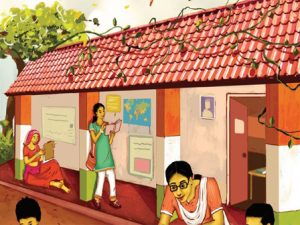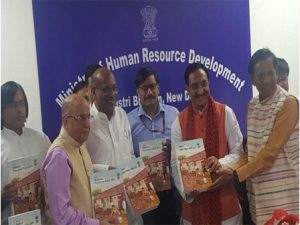National Education Policy, 2019: Futuristic, but at a Price
With suggestions for creating a new structure of schooling, institutional mechanisms and curriculum control, the draft National Education Policy (NEP) only subserves the interests of the political order of the day. Since education effectively determines the future of our democracy, larger consultations should be initiated at national level with diverse stakeholders before the Draft NEP is taken forward.

The Ministry of Human Resource Development (MHRD) opened the draft National Education Policy (NEP), 2019 for public review on 1 June 2019. Drafted by the Committee for Draft National Educational Policy led by Dr. Krishnaswamy Kasturirangan, the policy seeks to address the challenges of access, equity, affordability and accountability plaguing the current education system in India.
The Indian state that came into being after Independence was a product of the anti-colonial struggle. Education played a vital role to widen its freedom movement and the formulation of a vision of what India would look like post-Independence. When the country became independent, its successive governments made several efforts to check the constant deterioration of the education system and revamp it effectively to provide equitable access to education. However, we haven’t been able to strike a balance of education with the society that we have planned for a free India. An analysis of education policies helps demonstrate this discordance.
A new education policy is very crucial for a country like India where the population of the youth alone is larger than the population of Europe. Hence, increased investment in education is an inevitable step. The previous Education Policy (formed in 1986 and amended in 1992) failed to anticipate future developments. Moreover, there was considerable irregularity and incompleteness in its implementation. It was not only the expansion of education that has been slow, but also the educational provision which remains differentiated in terms of quantitative and qualitative aspects.
Also Read : Detention Failing Students Or Failing Education
The NEP had taken over public discourse with its mentioning of Hindi as a mandatory language, which was revised following public outrage, but it has other significant elements. There are recommendations for School Education to decrease the idea of rote learning and enable students to focus on developing their scientific temper and logical mindset.
It has proposed a change in the structure of the schooling—starting schooling from three years of age, merging 9–12 standards into an eight-semester framework, creating new school complexes and Special Educational Zones for backward areas.
An Early Childcare Education (ECE) framework guideline has been recommended for cognitive stimulation of 0–3-year-old, and in due course, basic communication and numerically based syllabus for 3–8-year olds. This is essential and can be implemented since the end-responsibility lies in the hands of the Anganwadi Centres, which are present at all local levels, as part of the Integrated Child Development Services (ICDS). However, the skill enhancement and availability of the Anganwadi workers need to be addressed. Further, in the next four years of primary education, there is an emphasis on reading, writing and numeric skills. With one in two students still not able to read and write up to these standards in India, this is not only necessary, but critical.
The proposed schooling structure is indicative of an end to junior colleges. Increasing the scope for Humanities, Commerce and Science ought to provide more disciplines to students, though this decision will face difficulties in some of the biggest states having the Junior College System. The junior colleges will have to be converted or shut down, which will result in ‘exits’ for children and prevent universalisation of education irrespective of whether the Right to Education (RTE) has been extended to 18 years of age. Major reasons for dropout include expensive and inaccessible education, migration, child labour, menstruation, marriage and lack of motivation to study. Increase in enrolment among children from marginalised communities, especially those indulging in child labour, can result by removing exits and making education compulsory for all children below 18 years. Similarly, the plan for merging the institutions for greater enrolments and a more diversified curriculum has potential for aggravating the structures of social discrimination. It ignores the factors which affect campus experience and demography.

Apart from the above, the importance of vocational studies has also been acknowledged in the NEP, with guidelines for the National Council of Educational Research and Training (NCERT) to create detailed curriculum. The curriculum designed should not only have ‘pure exchange value’, but also ‘use-value’. This will lead to control of curriculum in the direct hands of the ruling party at the Centre.
Another basic feature of the policy is the introduction of the Remedial Instructional Aides Programme (RIAP) and National Tutor Program (NTP), which will be conducted by peer students, local instructors and volunteers, such as retired teachers. This will aim at building the capacity of especially dropout students who re-enrol in the classes. Implementation of such a Pan-India educational reform would be challenging owing to the diverse social, economic and political situation of a largest democracy like India.
The draft announces the creation of the Rashtriya Shiksha Sangh. The Sangh is an apex body, which will undermine the autonomy of the MHRD and create dual centres of power. It will further add to the existing throttlehold on academics with massive potential for misuse of money depending on the interests of the political order of the day.
There is lack of lucidity regarding internships and placements. The National Research Fund will receive 20,000 crore over the course of 10 years and will be overseen by a governing body that controls research grants. This governing body and the Rashtriya Shiksha Aayog (RSA) above it, in consultation with ‘Divisional Councils’, in turn, will consult with the Chairperson of Subject Committee, which will only result in too many people making decisions.
Quality of education is another issue that the draft has addressed, but not discussed in detail. As only 12.7 per cent schools in India comply with the RTE norms, a roadmap for existing norms must be laid down.
Also Read : Divided Over Detention
While the mentioning of detailed plans of introducing new teachers and appointing them through Continuous Development Program (CDP) is a good initiative, there is lack of attention given to the older teachers and their capacity building processes, which neglects the role they play in the dialogue of change.
The draft NEP does not specify how the digitalisation of classrooms will take place, which is another issue of concern. It includes guidelines for the digitalisation of open schools for migratory children, where the majority of them belong to informal labourers. These students don’t have access to basic education, let alone digital aid.
The sexual issue is another one that has been ignored. According to Delhi Police, around 60 per cent of child abuse cases reported in Delhi are incidents from school. In reality, the number would be much higher. The absence of redressal mechanisms in schools is a gap that cannot be filled. Although sex education in 9th to 12th-grade has been discussed, it remains inadequate to deal with the issue of child abuse. The policy has a section devoted to transgender, but it doesn’t specify anything concrete other than that already exists. Disability should receive more emphasis and be drafted in line with the provisions of the PWD Act 2016.
The draft policy calls for a lot of investment, and if the government, given the constraints, is unable to increase the budget in the education sector, it can lead to the policy being pushed to a Private–Public Partnership (PPP) model extensively. Further, if not monitored well, it can lead to greater inequality over access to education. Mushrooming of institutions through PPP is not very beneficial for the demographic dividend of our country. It will lead to the commodification of education making it accessible to the privileged few. Thus, regulatory frameworks must be in line with existing human rights frameworks and should be backed by robust enforcement mechanisms. A survey by AISHE 2014 showed that even though the number of private colleges (132) is higher than the number of government colleges (122) in Himachal Pradesh, the enrolment is higher in government colleges (64 per cent) than in private colleges (36 per cent).
Education is an issue that effectively determines the future of democracies across the world. In the light of the above observations, larger consultations should be initiated at national level with diverse stakeholders before the Draft NEP is taken forward. It is time for the society at large to take responsibility and understand the role of education in nation-building that promotes coherence in a diverse society like ours.
